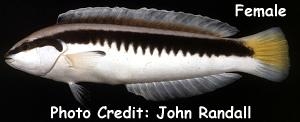
By Bob Goemans

Not Reef Tank Suitable
Likely Fish-Only Tank Suitable
Range: Western Pacific Ocean: Australia, and New Zealand.
Size: 10 inches (25 cm)
Natural Environment: Inhabits fairly deep sandy areas around rocky reefs and usually found at depths between 10 – 65 feet (3– 20 m) where it feeds on benthic invertebrate, usually hard-shelled invertebrates.
General Husbandry: Rarely seen in the trade with males and females having a whitish body with a black horizontal bar from the snout to the caudal peduncle, some yellow on the tail and dark red on the upper body.
Best maintained in fish-only aquariums having a fine sand bed, (0.5 – 2.0 mm) and at least 4 inches deep (For juveniles), along with several rocky crevices to hunt and also open swimming areas. Those in this genus will not only rearrange bottom dwelling corals in its search for tasty bottom dwelling invertebrates, as it will eat smaller fishes, snails, tubeworms, sea stars, cucumbers, urchins, crabs, and shrimp that it can find, it will also quickly burrow into the sand bed if frightened or for sleeping at night. This diving into the sand bed will cause clouds of sand particles to be dispensed into the water, and would cause various corals harm, therefore, as mentioned above, those in this genus, depending upon their size, are not often recommended for reef aquariums.
Preferable tankmates are those that are larger and somewhat aggressive, e.g., groupers, angelfishes, hawkfishes, and moderately aggressive triggerfishes.
Requires a meaty diet, including fortified brine shrimp, mysis, and other meaty type marine-based frozen or fresh foods, and should be fed twice daily.
Taxonomy:
Order: Perciformes
Suborder: Labroidei
Family: Labridae
Genus: Coris
FYI: A somewhat cool water species.
Upon first entering into the aquarium, may stay buried for days. Simply await its decision when to emerge. Once established, it will go to sleep under the sand and arise the next morning at almost the exact same time every day!
The aquarium should have small pieces of rocks for the wrasse to ‘play’ with in its daily search for prey.
Can greatly stir bottom sandbeds creating large clouds of sand being dispensed in many directions.
Smaller tankmates may be at risk of being attacked or harassed as this species grows to adulthood.
Slow swimming tankmates cannot compete with this wrasse at feeding time.
One male per aquarium.
Hardy species.
Experience Level: Intermediate
Temperament: Semi-aggressive
Diet: Carnivore
Coral Safe: Yes
Fish Safe: With caution
Invertebrate Safe: With caution
Acclimation Time: 30 minutes+
Aquarium Environment: Fish-only aquarium
Tankmates: Larger, active and moderately aggressive
Minimum Tank Size: 150 gallons
Temperature Range: 68 - 76°F (20 – 25°C)
Specific Gravity: 1.020 - 1.026
pH: 8.0 - 8.5
